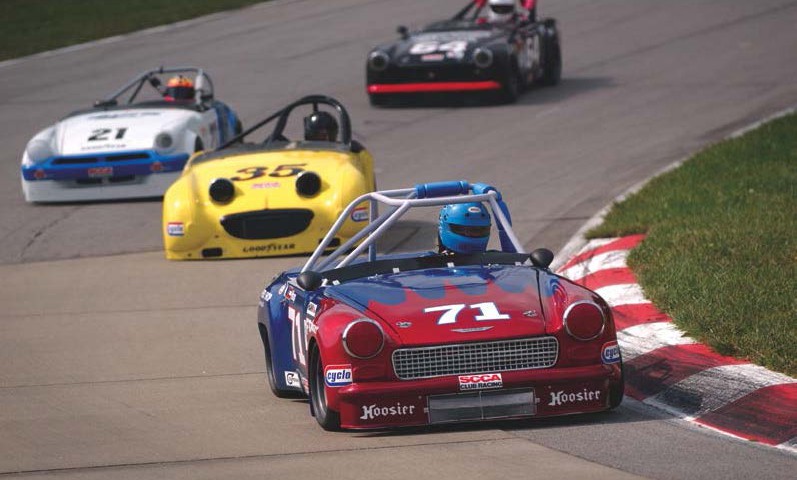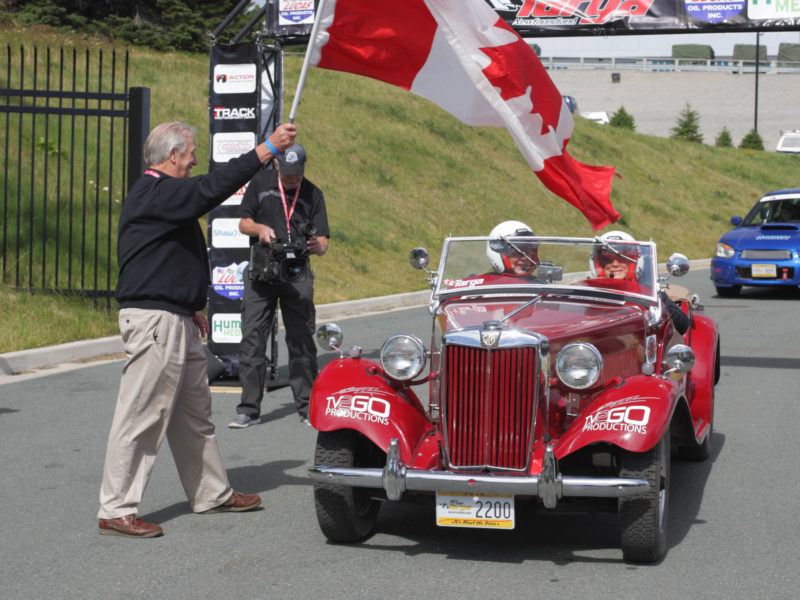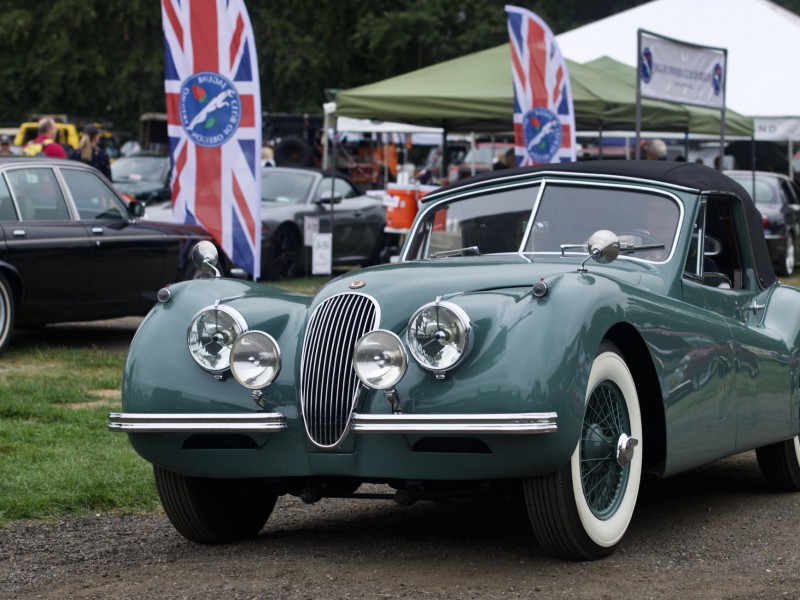Triumph, MG and Austin-Healey win big at the 2002 SCCA Valvoline Runoffs
By Leonard Emanuelson; photography by Bob Ucker/Showcase Photo
I’ve been a road-race fan for years, but vintage British sports cars have never been on my radar. That all changed on a lazy Sunday afternoon last November. I was driving my wife insane channel surfing the various auto racing broadcasts. The Winston Cup championship was coming down to a shootout, and being a big Tony Stewart fan, I tuned into the start of the race and settled in for an afternoon of Detroit heavy metal. At the first commercial, I switched over to Speed Channel to check out the action. They were airing the H/Production race from the 2002 SCCA Valvoline Runoffs held September 16-22 at the Mid-Ohio Sports Car Course. Mid-Ohio Sports Car Course is arguably one of the best and most scenic road courses in America: 2.28 miles long and extremely challenging.
By the time I tuned in, a pair of Bugeye Sprites and an MG Midget had checked out from the rest of the field, putting on a first-class racing clinic. These guys were working each other over, four-wheel drifting through every corner lap after lap. Tony Stewart would have to wait. I immediately fell in love with the way these cars looked, the way they raced, and the sounds they made.
The 20-lap H/Production SCCA championship was over all too soon. Bob Weber’s yellow #35 Bugeye took the checkered flag, closely pursued by Dan Collishaw in another Bugeye and Ron Bartell in an MG Midget. Later, in post-race inspection, Weber was disqualified for a minor engine rule infraction, and the win went to Collishaw. Bartell moved up to second, and 62-year-old Phil Chiles got a podium finish with his brilliant red #86 Bugeye in his last race before retiring from competition. I switched back to Winston Cup to check Tony’s progress.
Next commercial and I’m back to Speed Channel, where I discovered more British sports car racing: a Legends program documenting Triumph’s factory race efforts at Sebring in ’63 and Le Mans in ’64. It was an interesting contrast between the ’60s factory works cars and the SCCA cars entered in this year’s Runoffs. At Sebring in ’63, the Triumph team of TR4s placed 1, 2, and 4 in GT Class 2. It was a dominant run that included winning both the ’62 and ’63 SCCA championships as well. Triumph would wind down its factory racing effort at Le Mans in ’65 with a team of four Spitfires.
Jump ahead 37 years to 2002. These under-l.5L British sports cars are still dominating, this time in SCCA H/Production and F/Production. More impressive, a lone MGA won the G/Production championship, defeating a host of more modern cars—including VW Golfs and Rabbits, a Fiat X 1/9, and a fleet of Datsun 510 sedans (renowned for their dominance in two-liter Trans Am racing).
After speaking with a few racers, I found that these small-displacement production classes are enjoying their largest participation in years, largely due to racer-friendly rule changes by the SCCA and a more liberal qualifying requirement for the Runoffs. In 2002, H/Production was populated by 13 A-H Sprites and 7 MG Midgets, all National-caliber cars. F/Production featured 15 MG Midgets, 4 A-H Sprites, and 2 Triumph Spitfires in the British camp versus a group that included a Porsche 356 and 914, a BMW 2002, Honda CRXs, and Mazda Miatas, to name a few.
F/Production National Champion Steve Sargis discussed what it takes to be competitive at the national level. He’s been racing in SCCA for 24 years and has three championships in G/Production to add to his new F/Production crown. His experience plays a major role in keeping his costs down. Steve’s race car is a Triumph Spitfire MK III, which can be raced with a dual-carb 1300cc engine or a single-carb 1500. Steve opts for the high-revving 1300 and builds his own engines: “It costs me about $5,000 to build a competitive engine with a billet crank and billet connecting rods. The same engine from a professional shop goes for $12,000-$13,000.”
In Production classes, the basic body, floorpan and suspension design must be retained as well as production brakes (although SCCA has allowed a rear disc brake upgrade from drums). Suspension pickup points can be changed, and most racers substitute coilover shocks for ease of chassis adjustability. Any four-speed manual transmission with a working reverse is allowed. Steve uses a Toyota case with custom “dog-engagement” gears. He shifts at a mind-boggling 8500 rpm, where the engine is cranking out about 140 hp.
Phil Chiles ended his racing career with a third-place finish in H/Production. He was quick to mention that he felt bad for Bob Weber’s disqualification because the slightly oversized valves offered no horsepower advantage. The 62-year-old also raced his Bugeye Sprite to a third-place finish in 2001, beating his son for the podium spot.
Phil gave us a few pointers on the preparation of his Sprite. Per the rules, his car retains the original wheelbase and track. It has altered suspension pickup points and coilover shocks like most of the cars in these classes. He uses a fiberglass front end that has fender flares for larger tires. The miniscule 948cc powerplant produces right at l00hp—not bad for the under-one-liter pushrod motor. His race-modified Sprite gearbox was built by Richmond Instruments at a cost of $4,000.
Phil is a late bloomer, attending his first driving school at age 55 in 1995. When asked about the total cost of building a competitive H/Production car, he answered that his very competitive Sprite is now for sale for $18,000. I asked about the best way for British Motoring readers to get involved in entry-level racing. He said that many cars race at a regional level with much less preparation. All you need is the approved safety equipment, including a fuel cell, an on-board fire system, and an approved roll bar and safety belts. Another fun way to race with the SCCA is to compete in its Improved Touring (IT) classes.
If you have a project car that’s a little too rough for restoration or missing too many pieces, building a dual-purpose, streetable vintage racecar could be an excellent option. After all, that’s the way it was in the ’60s—install a roll bar and lap belt, drive to the track, tape up the headlights, and go race. It’s a little more complicated (and safer) now, but the bang for your buck can hardly be duplicated anywhere else in racing.
I’m searching the classifieds for a beater Midget or Spitfire. At the prices of used racecars, that may even be a better way to go—instead of adding race gear, you just retrofit some street-legal equipment. Either way, I’ll see ya at the track!








'British Invade Mid-Ohio' has no comments
Be the first to comment this post!